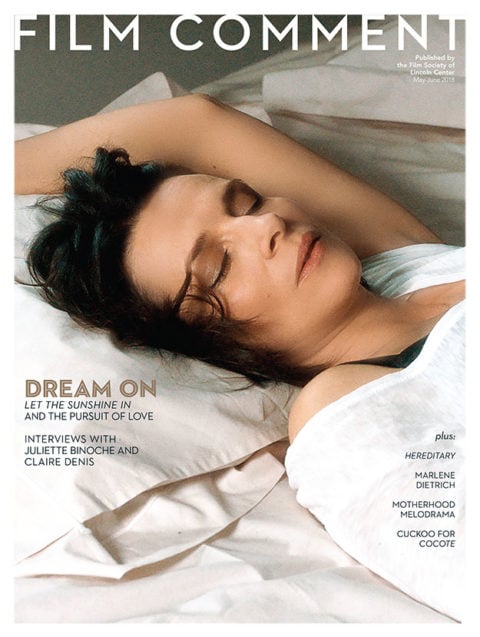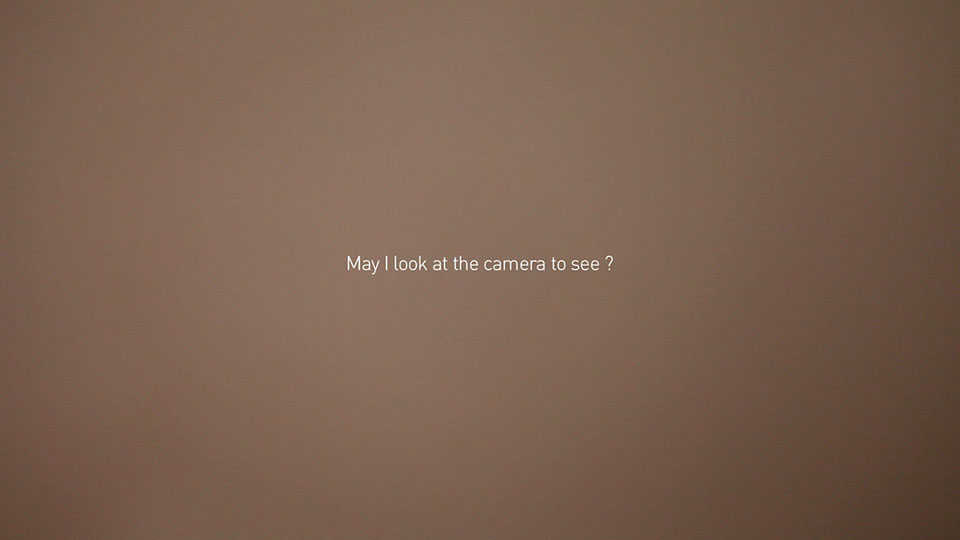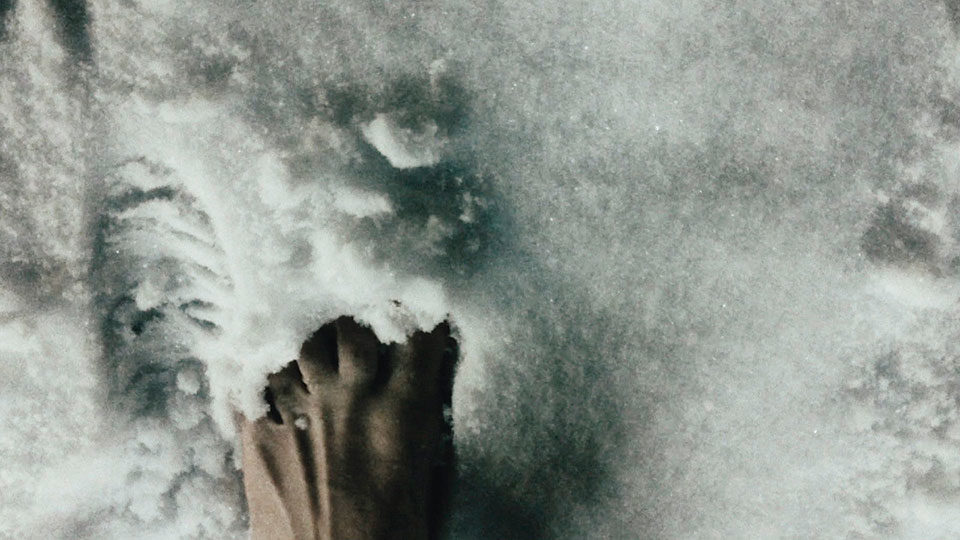By Eric Hynes in the May-June 2018 Issue

Seeing in the Dark
Making something out of nothing, some filmmakers use blank screens to fill our minds
There’s plenty to see in Extinction, a new film by Portuguese director Salomé Lamas. In black, white, and smoky gray, a young man stares back at us in slow motion. That same man sits in the back of a car as it hurtles down wet streets, then wanders around desolate landscapes, conversing with various strangers about the collapse of the Soviet Union and the splintering that followed. Yet no matter how arresting these images are, the most important activities in Extinction aren’t visually depicted.

From the May-June 2018 Issue
Also in this issue
In fact, for many minutes at a time, there’s nothing to see at all, save for a dark-blue depthless expanse disrupted only by subtitles. There’s still a picture—note the blueness, not blackness—but it’s one you have to populate for yourself. It’s like looking at a fully fogged window: something’s supposed to be there, something should come through there. You’re drawn to the frame and also past it, replacing a lack of projected imagery with your own private projections of what’s missing. Private in that they’re invisible to others and subjective in detail, prompted and motivated by what’s objectively present and richly suggestive: the soundtrack.
There’s much—far too much for a single column—to be said about the qualities of cinematic sound. But what’s particularly evocative about its role in Extinction, as well as in some other recent works of nonfiction, is its interplay with thwarted expectations for visuals. These aren’t radio pieces or podcasts, in which an element of cinematic theatricality might be situational (such as when radio pieces are attended by a live audience, or when foreign-language podcasts are presented with subtitles, à la Eleanor McDowall’s Radio Atlas series). These are films in which an empty screen isn’t solely a formal condition, but rather something active, unstable, provocative, meaningful. Here sound doesn’t merely fill in what’s absent, it challenges and converses with a screen that answers back with pointed opacity. Meanwhile the viewer, while ideally always engaged, has no choice but to actively process and synthesize, to get to work.

Foyer
Consider Derek Jarman’s Blue (1993), a masterpiece in this vein, which sonically constructs room after room of memories, emotions, aphorisms, characters, stray thoughts, and impassioned declarations—all somehow related to, emitted from, and poured into a vibrating horizontal canvas of cobalt blue. Faced with Jarman’s visionary deathbed opus, your eyes aren’t closed, you’re not getting lost in the infinite space of your own darkness—you’re open and awake to his blues. As with up-close viewings of monochromatic minimalist paintings (Yves Klein was an inspiration for Jarman), your eyes aren’t even primarily visual tools anymore, they’re quivering, overactive muscles. You stop looking for shapes in the color; instead, the color starts shaping you.
By contrast, the color and depth of field change, if very subtly, throughout Ismaïl Bahri’s Foyer (2016). In lieu of a solid fixed color, and in lieu of impeccable audiovisual production, Bahri affixes a white sheet loosely in front of a digital camera set outside on a busy, breezy Tunisian street. Thanks to the live audio, much of which centers around passersby’s commentary on Bahri’s small spectacle, mere undulations of gray—courtesy of the breeze and the camera’s overactive autofocus—play out as a tense, prolonged cliffhanger. The viewer is caught between fixating on the sheet, hoping to be able to see something, and doing his or her own work to imagine the landscape and characters that richly populate the soundtrack.
Blowing around in that Tunisian breeze are snippets of dialogue intimating at national and cultural uncertainty, giving Bahri’s seemingly ad hoc visual ploy a subtle political heft. It resonates with Lamas’s approach in Extinction, in which visuals are arrested whenever our young protagonist, along with the film’s crew, attempts to cross a series of borders in eastern Europe. These checkpoints of Ukraine, Romania, Moldova, Transnistria, and Russia, are netherlands where cameras are seemingly unwelcome but also perhaps irrelevant. There’s a shifty indeterminacy to these crossings that merits witness, but it’s also possible that visual witness won’t make anything more legible. Hear the posturing, hear the dissembling, hear the grift come through loud and clear. That feeling of being nowhere and somewhere at the same time—one moment in an inter-nationally recognized nation, the next in disputed, supposedly illegitimate territory; one moment having physical autonomy, the next being denied free movement—is profoundly expressed by Lamas’s formal gambit. (Whether or not the gambit is motivated by necessity or theory, it plays persuasively as the former, legitimizing the latter.)
Based on the audio, you might picture what’s happening, perhaps even vividly. Thwarting one sense often heightens the capacities of another. But the point isn’t merely to play with our senses. Our subjective understanding of these events parallels those of travelers who never know what new reality they’re walking into—“the situation has changed a bit,” a border guard says to justify detention—never know what improvised law will be used against them, never know which crossing will turn out to be a barrier. Creativity along the margins can be liberating; it can also be corrupting and subjugating.

I Had Nowhere to Go
At Copenhagen’s CPH:DOX, an enormous documentary festival that balances art-mindedness with industry amenability, Extinction played in the main competition alongside more maximalist entries such as Last Year in Utopia, Bisbee ’17, and jury award–winner The Raft. But its minimalist strategy was echoed elsewhere in the festival by Gilad Baram and Adam Kaplan’s The Disappeared, in which two textures of blank screen—noiseless digital and fuzzy VHS—alternate against testimonies of an unreleased, big-budgeted feature-length work of Israeli military propaganda. The absence of visuals represents a movie unseen, as well as the undoing—at seemingly every step of the way—of a well-intentioned story aimed at combating suicide in the military. Gradually, thanks to 46 minutes of anecdotes, descriptions by those who took part, sound effects, and the film’s finished score, viewers might be forgiven for thinking they’ve actually seen clips from the shelved production. Furthermore, when pages of the script are read aloud at the end—a repeat of The Disappeared’s opening moments—a by-all-accounts misbegotten, ham-fisted, and to-date non-movie gets marshaled into something vital and emotive. In effect Baram and Kaplan have saved their source film from itself, encouraging and allowing the viewer to imagine a more effective picture in its void.
These recent experiments called to mind I Had Nowhere to Go, Douglas Gordon’s collaboration with and tribute to nonagenarian experimental filmmaker Jonas Mekas, which made the festival rounds in 2016. Nearly everything goes unseen in the film, yet Gordon’s empty screen serves less as a dark canvas on which to project Mekas’s spoken remembrances than as a neutralizing monolith. No doubt there’s much to picture in Mekas’s often harrowing stories of flight from Lithuania during the Second World War, which involved living in a Nazi prison camp and escaping to the U.S. But Gordon’s sporadic insertions of imagery function as near non sequiturs—here, briefly, is a gorilla, several minutes after Mekas mentioned one, and not even this one, in passing—serving to effectively rebut our impulses to fill in the gaps. What it does is train our ears, instead of satisfying our eyes, so that Mekas’s voice, with all of its accented character, poetic cadences, and refined melancholy, absorbs our attention.
If Gordon had withheld visuals entirely, we’d settle into the experience as we might a radio broadcast, free to concentrate our eyes wherever we might, and bring Mekas’s voice into our own individual space. Whereas these rare, unevenly spaced glimpses of things that are never the thing situate us in the cinema, if unfamiliarly. It’s another move that disciplines our eyes so that we’ll really listen.
Eric Hynes is a journalist and critic, and curator of film at Museum of the Moving Image in New York.







